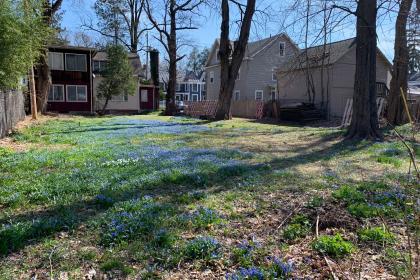
After a whirlwind awareness and fundraising campaign in 2019, we successfully protected the Pine Street African Burial Ground in partnership with Harambee and in collaboration with Scenic Hudson. Since then, we have continued to work with Harambee and other community partners to steward and plan for the future of this sacred site.
First Youth-led Community Design Process Complete
We were thrilled to recieve $20,000 from the 2019 City of Kingston Participatory Budget for the creation of a youth-led design process for the site with project partners Harambee, Kingston YMCA Farm Project, KaN Landscape Design, and Growing Films.* The Youth Design Team met for a series of community events, field trips, and design workshops between November 2019 and March 2020. Over the course of the project period, KaN Landscape Design facilitated educational workshops in which the team learned things like site analysis and planning; how to evaluate existing conditions, constraints and assets; and finally allowed them to propose informed and creative answers for a site design.
Workshops included field trips to significant sites like the Pine Street Burial Ground, Mt. Zion Cemetery, A.J. Williams-Myers African Roots Library, and Mass Design’s Hudson Valley Design Lab. Students and project partners also took a field trip to New York City, where they visited the 9/11 Memorial, the Oculus subway station, the African Burial Ground National Monument, and shared a West African inspired meal at a restaurant at The Africa Center. Throughout the experience, students connected with expert architects, designers, historians, and other professionals from organizations including DRAW Kingston, the Circle Creative Collective, Mass Design, the National Park Service, the Deep Listening Institute, and Seedshed.
As the Youth Design Team accumulated knowledge around design and the history of the black experience in Kingston and America, they developed and revised design concepts to memorialize the burial ground. KaN Landscape Design synthesized the team’s designs into professional renderings. At the end of the project, the team organized a well attended community design charrette at the Ulster County Restorative Justice and Youth Empowerment Center, to present their work to the community. In reflecting on this project capstone, KaN co-designer Karine Duteil related:
“I felt a shift from the community to seeing the teenagers as true community leaders. Like a recognition of leadership. It is as though we created a rite of passage for the youth and for the community as well, like a relay baton. There was this collective moment of revelation and hope as a community for the future.”
Results and Impact of the Youth Design Process
The designs and renderings from the Youth Design Team’s project will provide a foundation for future rounds of community input, ultimately culminating in a final implementable design. The project fulfilled its original goal of creating an educational methodology, and an immersion into local history and culture through investigative learning and community engagement.The team inspired the Kingston community through their dedication and personal commitment to the project. Students from the team facilitated their own series (of 3) “Teens Teaching Teens” workshops in honor of late Harambee board member Esther Taylor-Williams, in which they relayed what they learned from the project to their peers. More broadly, the project has caught the attention of professional land protection, historic, design, and social justice organizations and can serve as a model for future community based design projects.
The Pine St. African Burial Ground was the subject of a City College of New York class led by Professor Jerome Haferd called “Speculative (Afro) Futures: The Pine Street Burial Ground, 2100 & Beyond”, in which students were tasked to design a futuristic memorial site in the context of assigned literature and spatial explorations. Students from Kingston and City College were able to exchange knowledge and provide input on eachothers’ designs. In May of 2020, the Afro-Futures class presented their final designs in a public Zoom event which was attended by members of the Youth Team and Kingston community.
In order to have a lasting impact, documentary footage recorded by Growing Films during this project will be used to tell a story of the burial ground and it’s design process. Growing Films, the Kingston Land Trust and Harambee continue to raise funds for this important film project, click here to make a donation or sponsor the film!
A Plan for Ownership and Permanent Protection
Currently the Kingston Land Trust continues to own and steward the property, but we have begun the process of developing terms to transfer the property to Harambee and while maintaining an easement to permanently protect the land as a sacred site. This plan was presented to the community earlier this year during a public meeting at the Restorative Justice Center during Black History Month, and received enthusiastic support. Once the transfer is complete, Harambee will lead design implementation with support from project partners and the community.
